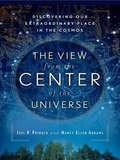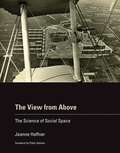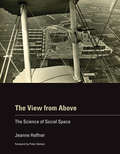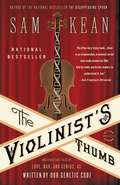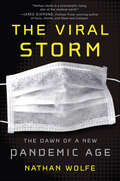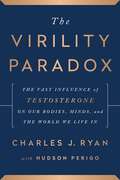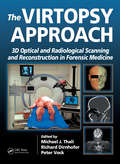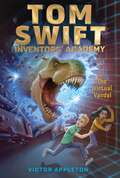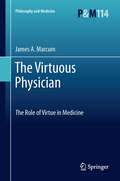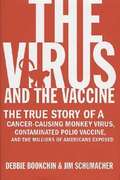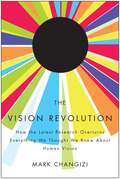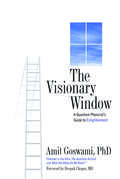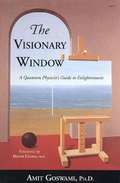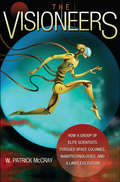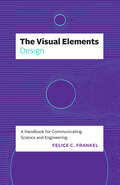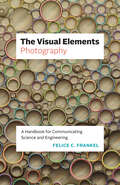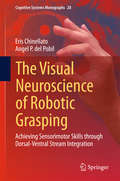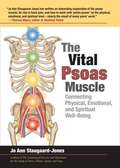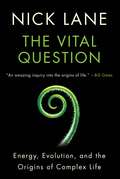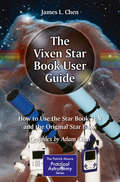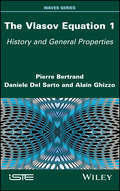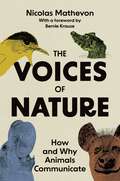- Table View
- List View
The View From the Center of the Universe: Discovering Our Extraordinary Place in the Cosmos
by Nancy Ellen Abrams Joel R. PrimackIn this strikingly original book, a world-renowned cosmologist and an innovative writer of the history and philosophy of science uncover an astonishing truth: Humans actually are central to the universe.<P><P> What does this mean for our culture and our personal lives? The answer is revolutionary: a science-based cosmology that allows us to understand the universe as a whole and our extraordinary place in it. .
The View from Above
by Jeanne Haffner Peter GalisonIn mid-twentieth century France, the term "social space" ( l'espace social) -- the idea that spatial form and social life are inextricably linked -- emerged in a variety of social science disciplines. Taken up by the French New Left, it also came to inform the practice of urban planning. In The View from Above, Jeanne Haffner traces the evolution of the science of social space from the interwar period to the 1970s, illuminating in particular the role of aerial photography in this new way of conceptualizing socio-spatial relations. As early as the 1930s, the view from above served for Marcel Griaule and other anthropologists as a means of connecting the social and the spatial. Just a few decades later, the Marxist urban sociologist Henri Lefebvre called the perspective enabled by aerial photography -- a technique closely associated with the French colonial state and military -- "the space of state control." Lefebvre and others nevertheless used the notion of social space to recast the problem of massive modernist housing projects (grands ensembles) to encompass the modern suburb (banlieue) itself -- a critique that has contemporary resonance in light of the banlieue riots of 2005 and 2007. Haffner shows how such "views" permitted new ways of conceptualizing the old problem of housing to emerge. She also points to broader issues, including the influence of the colonies on the metropole, the application of sociological expertise to the study of the built environment, and the development of a spatially oriented critique of capitalism.
The View from Above: The Science of Social Space
by Jeanne HaffnerThe role of aerial photography in the evolution of the concept of social space”and its impact on French urban planning in the mid-twentieth century.In mid-twentieth century France, the term “social space” (l'espace social)—the idea that spatial form and social life are inextricably linked—emerged in a variety of social science disciplines. Taken up by the French New Left, it also came to inform the practice of urban planning. In The View from Above, Jeanne Haffner traces the evolution of the science of social space from the interwar period to the 1970s, illuminating in particular the role of aerial photography in this new way of conceptualizing socio-spatial relations. As early as the 1930s, the view from above served for Marcel Griaule and other anthropologists as a means of connecting the social and the spatial. Just a few decades later, the Marxist urban sociologist Henri Lefebvre called the perspective enabled by aerial photography—a technique closely associated with the French colonial state and military—“the space of state control.” Lefebvre and others nevertheless used the notion of social space to recast the problem of massive modernist housing projects (grands ensembles) to encompass the modern suburb (banlieue) itself—a critique that has contemporary resonance in light of the banlieue riots of 2005 and 2007. Haffner shows how such “views” permitted new ways of conceptualizing the old problem of housing to emerge. She also points to broader issues, including the influence of the colonies on the metropole, the application of sociological expertise to the study of the built environment, and the development of a spatially oriented critique of capitalism.
The Violinist's Thumb: And Other Lost Tales of Love, War, and Genius, as Written by Our Genetic Code
by Sam KeanFrom New York Times bestselling author Sam Kean comes more incredible stories of science, history, language, and music, as told by our own DNA. In The Disappearing Spoon, bestselling author Sam Kean unlocked the mysteries of the periodic table. In THE VIOLINIST'S THUMB, he explores the wonders of the magical building block of life: DNA.There are genes to explain crazy cat ladies, why other people have no fingerprints, and why some people survive nuclear bombs. Genes illuminate everything from JFK's bronze skin (it wasn't a tan) to Einstein's genius. They prove that Neanderthals and humans bred thousands of years more recently than any of us would feel comfortable thinking. They can even allow some people, because of the exceptional flexibility of their thumbs and fingers, to become truly singular violinists.Kean's vibrant storytelling once again makes science entertaining, explaining human history and whimsy while showing how DNA will influence our species' future.
The Viral Storm: The Dawn of a New Pandemic Age
by Nathan Wolfe“One of the world’s foremost virus hunters” (Financial Times), Stanford University biologist Nathan Wolfe reveals the origins of the world’s most deadly diseases and how we can combat and stop contagions.A “mix of biology, history, medicine, and first-hand experience [that] is potent and irresistible,”* The Viral Storm: The Dawn of a New Pandemic Age shares information Wolfe uncovered on his groundbreaking and dangerous research missions in the jungles of Africa and the rain forests of Borneo to provide an in-depth exploration of how lethal viruses evolved alongside human beings; how illnesses like HIV, swine flu, and bird flu almost wiped us out in the past; and why modern life has made our species vulnerable to the threat of a global pandemic.In a world where each new outbreak seems worse than the one before, Wolfe points the way forward, as new technologies are brought to bear in the most remote areas of the world to neutralize these viruses and even harness their power for the good of humanity. His provocative vision of the future will change the way we think about viruses, and perhaps remove a potential threat to humanity’s survival.“An astonishingly lucid book on an important topic. Deeply researched, yet effortlessly recounted.”—*Siddhartha Mukherjee, Pulitzer Prize-winning author of The Emperor of All Maladies
The Virility Paradox: The Vast Influence of Testosterone on Our Bodies, Minds, and the World We Live In
by Charles J. RyanTestosterone makes us stronger, happier, and smarter. It also makes us meaner, more violent and more selfish. A scientific look into the vast and unexpected influence testosterone has on our behavior, our society, and our bodies. The brain of every man—and every woman—is shaped by this tiny molecule from before birth: it propels our drive for exploration and risk, for competition and creation, and even our survival. The effects of testosterone permeate the traditions, philosophy, and literature of every known culture—without it, the world would be a drastically different place. Testosterone also has a role in humanity's darker side, contributing to violence, hubris, poverty, crime, and selfishness. Recent revelations of the science of testosterone show that high levels will deplete compassion and generosity, and even reduce the affection we show our children. In The Virility Paradox, internationally renowned oncologist and prostate cancer researcher Charles Ryan explores this complex chemical system responsible for a diverse spectrum of human behaviors and health in both men and women. Ryan taps his vast experience treating prostate cancer with testosterone-lowering therapy, observing that this often leads to profound changes in the patients' perspectives on their lives and relationships. Often, for the better. Ryan uses the journeys of these patients and others to illustrate the vast and sometimes unexpected influence testosterone has on human lives. Through the stories of real men and women, he also explores the connections between testosterone and conditions like dementia, autism, and cancer, as well as the biological underpinnings of sexual assault and the effects it has on everything from crime to investing to everyday choices we make. Integrating the molecular and the medical, sociology and storytelling, The Virility Paradox;offers a fascinating look at how one hormone has shaped history, and the connections between our biology, our behavior, and our best selves.
The Virtopsy Approach: 3D Optical and Radiological Scanning and Reconstruction in Forensic Medicine
by Michael J. Thali Richard Dirnhofer Peter VockCharred, badly decomposed, or mummified corpses, as well as those restrictions forced upon coroners by certain religious sects, often make autopsies impossible to perform. In addition, lack of manpower among the personnel charged with performing autopsies frequently creates a backlog of cases in the coroner‘s office. This delay increases the likeli
The Virtual Vandal: The Drone Pursuit; The Sonic Breach; Restricted Access; The Virtual Vandal (Tom Swift Inventors' Academy #4)
by Victor AppletonTom and his friends attend a science camp in this fourth novel in Tom Swift Inventors&’ Academy—perfect for fans of The Hardy Boys or Alex Rider. Every year, Swift Academy students go to a nearby summer camp to field-test their inventions. Tom and his friends have been working hard on all their projects, but they&’re most thrilled about Noah&’s new virtual reality simulation. They can&’t wait for it to go live, and everyone is looking forward to running tests at the camp. Nothing dulls their excitement, not even when a mysterious prankster starts messing with people&’s inventions. But things take a nosedive when the pranks turn into vandalism. To make matters worse, clues point to Tom&’s friend, Sam, as the one responsible. With Sam&’s reputation and student projects on the line, it&’s up to Tom and his friends to unmask the true vandal. And when Noah&’s simulation enters the arena, they quickly discover they&’re not the only ones meeting in virtual reality…
The Virtuous Physician
by James A. MarcumAlthough modern medicine enjoys unprecedented success in providing excellent technical care, many patients are dissatisfied with the poor quality of care or the unprofessional manner in which physicians sometimes deliver it. Recently, this patient dissatisfaction has led to quality-of-care and professionalism crises in medicine. In this book, the author proposes a notion of virtuous physician to address these crises. He discusses the nature of the two crises and efforts by the medical profession to resolve them and then he briefly introduces the notion of virtuous physician and outlines its basic features. Further, virtue theory is discussed, along with virtue ethics and virtue epistemology, and specific virtues, especially as they relate to medicine. The author also explores the ontological priority of caring as the metaphysical virtue for grounding the notion of virtuous physician, and two essential ontic virtues--care and competence. In addition to this, he examines the transformation of competence into prudent wisdom and care into personal radical love to forge the compound virtue of prudent love, which is sufficient for defining the virtuous physician. Lastly, two clinical case stories are reconstructed which illustrate the various virtues associated with medical practice, and it is discussed how the notion of virtuous physician addresses the quality-of-care and professionalism crises.
The Virus and the Vaccine: The True Story of a Cancer-Causing Monkey Virus, Contaminated Polio Vaccine, and the Millions of Americans Exposed
by Debbie Bookchin Jim SchumacherA comprehensive story of the problems and concerns associated with the polio vaccine
The Vision Revolution: How the Latest Research Overturns Everything We Thought We Knew About Human Vision
by Mark ChangiziIn The Vision Revolution: How the Latest Research Overturns Everything We Thought We Knew About Human Vision, Mark Changizi, prominent neuroscientist and vision expert, addresses four areas of human vision and provides explanations for why we have those particular abilities, complete with a number of full-color illustrations to demonstrate his conclusions and to engage the reader. Written for both the casual reader and the science buff hungry for new information, The Vision Revolution is a resource that dispels commonly believed perceptions about sight and offers answers drawn from the field's most recent research. Changizi focuses on four &“why" questions: 1. Why do we see in color? 2. Why do our eyes face forward? 3. Why do we see illusions? 4. Why does reading come so naturally to us? Why Do We See in Color? It was commonly believed that color vision evolved to help our primitive ancestors identify ripe fruit. Changizi says we should look closer to home: ourselves. Human color vision evolved to give us greater insights into the mental states and health of other people. People who can see color changes in skin have an advantage over their color-blind counterparts; they can see when people are blushing with embarrassment, purple-faced with exertion or the reddening of rashes. Changizi's research reveals that the cones in our eyes that allow us to see color are exquisitely designed exactly for seeing color changes in the skin. And it's no coincidence that the primates with color vision are the ones with bare spots on their faces and other body parts; Changizi shows that the development of color vision in higher primates closely parallels the loss of facial hair, culminating in the near hairlessness and highly developed color vision of humans. Why Do Our Eyes Face Forward? Forward-facing eyes set us apart from most mammals, and there is much dispute as to why we have them. While some speculate that we evolved this feature to give us depth perception available through stereo vision, this type of vision only allows us to see short distances, and we already have other mechanisms that help us to estimate distance. Changizi's research shows that with two forward-facing eyes, primates and humans have an x-ray ability. Specifically, we're able to see through the cluttered leaves of the forest environment in which we evolved. This feature helps primates see their targets in a crowded, encroached environment. To see how this works, hold a finger in front of your eyes. You'll find that you're able to look &“through" it, at what is beyond your finger. One of the most amazing feats of two forward-facing eyes? Our views aren't blocked by our noses, beaks, etc. Why Do We See Illusions? We evolved to see moving objects, not where they are, but where they are going to be. Without this ability, we couldn't catch a ball because the brain's ability to process visual information isn't fast enough to allow us to put our hands in the right place to intersect for a rapidly approaching baseball. &“If our brains simply created a perception of the way the world was at the time light hit the eye, then by the time that perception was elicited—which takes about a tenth of a second for the brain to do—time would have marched on, and the perception would be of the recent past," Changizi explains. Simply put, illusions occur when our brain is tricked into thinking that a stationary two-dimensional picture has an element that is moving. Our brains project the &“moving" element into the future and, as a result, we don't see what's on the page, but what our brain thinks will be the case a fraction of a second into the future. Why Does Reading Come So Naturally to Us? We can read faster than we can hear, which is odd, considering that reading is relatively recent,
The Visionary Window
by Amit Goswami M.D. Deepak ChopraAfter almost a century of using quantum physics to delve into mystery of matter, it is clear that by itself it is not complete; the conscious observer is necessary to complete it. Thus opens the visionary window, introducing into science the idea of consciousness as the ground of all being and the metaphysical basis for a new paradigm...-Adapted from the PrefaceDoes God exist? Can spirituality be integrated with science? Is happiness possible? Do miracles really happen? Not only does The Visionary Window answer " yes" to all of these questions, but it skillfully combines the fields of philosophy, cosmology, religion, and psychology to form a new way of thinking about science and spirituality.Stepping beyond the classic work of prominent seventies physicist Fritjof Capra, Goswami details his own pioneering exploration of science and spirit, revealing the complete integration between modern science and spiritual traditions. Using stories and colorful examples from pop culture, Goswami addresses complex issues in language and terminology easily accessible to the lay reader. He provides quantum physics-based theory and new experimental data verifying the metaphysical truth that exists when employed in the context of a new science, science within the primacy of consciousness.With a new holistic worldview, Goswami also discusses the creativity of the body to self heal; the power of spiritual practice and how to choose a meditative path; and the five stages of spiritual growth, culminating in the ability to transcend the physical laws of nature. Readers, scientists and spiritual leaders alike will find answers to many of life's deepest mysteries.
The Visionary Window
by Deepak Chopra Amit GoswamiDoes God exist? Can spirituality be integrated with science? Is happiness possible? Do miracles really happen? Not only does The Visionary Window answer " yes" to all of these questions, but it skillfully combines the fields of philosophy, cosmology, religion, and psychology to form a new way of thinking about science and spirituality. Stepping beyond the classic work of prominent seventies physicist Fritjof Capra, Goswami details his own pioneering exploration of science and spirit, revealing the complete integration between modern science and spiritual traditions. Using stories and colorful examples from pop culture, Goswami addresses complex issues in language and terminology easily accessible to the lay reader. He provides quantum physics-based theory and new experimental data verifying the metaphysical truth that exists when employed in the context of a new science, science within the primacy of consciousness. With a new holistic worldview, Goswami also discusses the creativity of the body to self heal; the power of spiritual practice and how to choose a meditative path; and the five stages of spiritual growth, culminating in the ability to transcend the physical laws of nature. Readers, scientists and spiritual leaders alike will find answers to many of life's deepest mysteries.
The Visionary Window: A Quantum Physicist's Guide to Enlightenment
by Amit GoswamiA thrilling synthesis of science and mysticism by a quantum physicist reared in the Hindu tradition with a thorough knowledge of Indian sacred literature. Goswami offers solid, scientific explanations for the concept of universal consciousness and the existence of mind beyond the function of the brain. Thoughtful readers will love his ingenious mix of data and ideas from Eastern philosophy, transpersonal psychology, and quantum physics to explore the scientific principles for why and how spiritual practice works.
The Visioneers
by W. Patrick MccrayIn 1969, Princeton physicist Gerard O'Neill began looking outward to space colonies as the new frontier for humanity's expansion. A decade later, Eric Drexler, an MIT-trained engineer, turned his attention to the molecular world as the place where society's future needs could be met using self-replicating nanoscale machines. These modern utopians predicted that their technologies could transform society as humans mastered the ability to create new worlds, undertook atomic-scale engineering, and, if truly successful, overcame their own biological limits. The Visioneers tells the story of how these scientists and the communities they fostered imagined, designed, and popularized speculative technologies such as space colonies and nanotechnologies. Patrick McCray traces how these visioneers blended countercultural ideals with hard science, entrepreneurship, libertarianism, and unbridled optimism about the future. He shows how they built networks that communicated their ideas to writers, politicians, and corporate leaders. But the visioneers were not immune to failure--or to the lures of profit, celebrity, and hype. O'Neill and Drexler faced difficulty funding their work and overcoming colleagues' skepticism, and saw their ideas co-opted and transformed by Timothy Leary, the scriptwriters of Star Trek, and many others. Ultimately, both men struggled to overcome stigma and ostracism as they tried to unshackle their visioneering from pejorative labels like "fringe" and "pseudoscience." The Visioneers provides a balanced look at the successes and pitfalls they encountered. The book exposes the dangers of promotion--oversimplification, misuse, and misunderstanding--that can plague exploratory science. But above all, it highlights the importance of radical new ideas that inspire us to support cutting-edge research into tomorrow's technologies.
The Visual Elements—Design: A Handbook for Communicating Science and Engineering (The Visual Elements)
by Felice C. FrankelWith insights and examples from designers at publications from Nature to the New York Times, an essential guide to creating figures and presentations. In this short handbook, award-winning science communicator Felice C. Frankel offers a quick guide for scientists and engineers who want to share—and better understand—their research by designing compelling graphics for journal submissions, grant applications, presentations, and posters. Like all the books in the Visual Elements series, this handbook is also a training tool for researchers. Distilling her celebrated books and courses to the essentials, Frankel shows scientists and engineers, from students to primary investigators, the importance of thinking visually. This crucial volume in the Visual Elements series offers a wealth of engaging design examples. Case studies and advice from designers at prestigious publications and researchers’ own before-and-after examples show how even the smallest changes—to color, type, composition, and layering—can greatly improve communication. Ideal for researchers who want a foothold for presenting and preparing their work for everything from conferences to publications, the book explains the steps for creating a concise and communicative graphic to highlight the most important aspects of research—and to clarify researchers’ own thinking. The resulting book is an essential element of any scientist’s, engineer’s, or designer’s library.
The Visual Elements—Photography: A Handbook for Communicating Science and Engineering (The Visual Elements)
by Felice C. FrankelFor novice or pro, primary investigator or postdoc, the essentials for photographing science and technology for journals, grant applications, and public understanding. Award-winning photographer Felice C. Frankel, whose work has graced the covers of Science, Nature,and Scientific American, among other publications, offers a quick guide for scientists and engineers who want to communicate—and better understand—their research by creating compelling photographs. Like all the books in the Visual Elements series, this short guide uses engaging examples to train researchers to learn visual communication. Distilling her celebrated books and courses to the essentials, Frankel shows scientists and engineers the importance of thinking visually. When she creates stunning images of scientific phenomena, she is not only interested in helping researchers to convey understanding to others in their research community or to gain media attention, but also in making these experts themselves “look longer” to understand more fully. Ideal for researchers who want a foothold for presenting and preparing their work for conferences, journal publications, and funding agencies, the book explains four tools that all readers can use—a phone, a camera, a scanner, and a microscope—and then offers important advice on composition and image manipulation ethics. The Visual Elements—Photography is an essential element in any scientist’s, engineer’s, or photographer’s library.
The Visual Neuroscience of Robotic Grasping
by Eris Chinellato Angel P. PobilThis book presents interdisciplinary research that pursues the mutual enrichment of neuroscience and robotics. Building on experimental work, and on the wealth of literature regarding the two cortical pathways of visual processing - the dorsal and ventral streams - we define and implement, computationally and on a real robot, a functional model of the brain areas involved in vision-based grasping actions. Grasping in robotics is largely an unsolved problem, and we show how the bio-inspired approach is successful in dealing with some fundamental issues of the task. Our robotic system can safely perform grasping actions on different unmodeled objects, denoting especially reliable visual and visuomotor skills. The computational model and the robotic experiments help in validating theories on the mechanisms employed by the brain areas more directly involved in grasping actions. This book offers new insights and research hypotheses regarding such mechanisms, especially for what concerns the interaction between the dorsal and ventral streams. Moreover, it helps in establishing a common research framework for neuroscientists and roboticists regarding research on brain functions.
The Vital Psoas Muscle: Connecting Physical, Emotional, and Spiritual Well-Being
by Jo Ann Staugaard-JonesLocated deep within the anterior hip joint and lower spine, the psoas major (usually just referred to as the psoas) is critical for optimal postural alignment, movement, and overall well being. The psoas is the only muscle in the human organism that connects the upper body to the lower body, and its importance extends to the nerve complex and energy systems. As modern-day populations grow more sedentary, psoas-related lower back and hip pain, and the ailment of "sitting too much," are on the rise. Even the most active of athletes can suffer from psoas imbalance and pain. The Vital Psoas Muscle demonstrates how to keep the muscle in balance through specific exercises designed to strengthen and utilize this amazing muscle, and discusses its vital role in the emotional and spiritual state of the human being. The interconnection between the psoas and the root chakra is explored, along with yoga poses and postures that stimulate the psoas. Eighty full-color illustrations depict anatomical details, and show the key stretching and strengthening exercises in this practical and comprehensive treatment of the most important skeletal muscle in the human body.
The Vital Question: Energy, Evolution, and the Origins of Complex Life
by Nick LaneTo explain the mystery of how life evolved on Earth, Nick Lane explores the deep link between energy and genes. The Earth teems with life: in its oceans, forests, skies and cities. Yet there's a black hole at the heart of biology. We do not know why complex life is the way it is, or, for that matter, how life first began. In The Vital Question, award-winning author and biochemist Nick Lane radically reframes evolutionary history, putting forward a solution to conundrums that have puzzled generations of scientists. For two and a half billion years, from the very origins of life, single-celled organisms such as bacteria evolved without changing their basic form. Then, on just one occasion in four billion years, they made the jump to complexity. All complex life, from mushrooms to man, shares puzzling features, such as sex, which are unknown in bacteria. How and why did this radical transformation happen? The answer, Lane argues, lies in energy: all life on Earth lives off a voltage with the strength of a lightning bolt. Building on the pillars of evolutionary theory, Lane's hypothesis draws on cutting-edge research into the link between energy and cell biology, in order to deliver a compelling account of evolution from the very origins of life to the emergence of multicellular organisms, while offering deep insights into our own lives and deaths. Both rigorous and enchanting, The Vital Question provides a solution to life's vital question: why are we as we are, and indeed, why are we here at all?
The Vitreous State
by Ivan S. Gutzow Jürn W.P. SchmelzerThis book summarizes the experimental evidence and modern classical and theoretical approaches in understanding the vitreous state, from structural problems, over equilibrium and non-equilibrium thermodynamics, to statistical physics. Glasses, and especially silicate glasses, are only the best known representatives of this particular physical state of matter. Other typical representatives include organic polymer glasses, and many other easily vitrifying organic and inorganic substances, technically important materials, amidst them vitreous water and vitrified aqueous solutions, and also many metallic alloy systems. Some of these systems only form glasses under particular conditions, e.g. through ultra-rapid cooling. This book describes the properties and the formation of both every-day technical glasses and especially of such more exotic forms of vitreous matter. It is a unique source of knowledge and new ideas for materials scientists, engineers and researchers working on condensed matter. The new edition emphasizes latest experimental findings and modern theories, explaining the kinetics of glass formation, the relaxation and stabilization of glasses and their crystallization in terms of new models, derived from the framework of the thermodynamics of irreversible processes. It shows how the properties of common technical glasses, window glass, or the vitreous ice kernel of comets can be used to develop a new understanding of the existence of matter in various, unusual forms. The described theories can even find application for the description of lasers and interesting unusual processes in the universe.
The Vixen Star Book User Guide
by James Chen Adam ChenThis book is for anyone who owns, or is thinking of owning, a Vixen Star Book Ten telescope mount or its predecessor. A revolution in amateur astronomy has occurred in the past decade with the wide availability of high tech, computer-driven, Go-To telescopes. Vixen Optics is leading the way by offering the Star Book Ten system, with its unique star map graphics software. The Star Book Ten is the latest version of computer telescope control using star map graphics as a user interface, first introduced in the original Star Book first offered in 2003. The increasingly complicated nature of this software means that learning to optimize this program is not straightforward, and yet the resulting views when all features are correctly deployed can be phenomenal. After a short history of computerized Go-To telescopes for the consumer amateur astronomer market, Chen offers a treasury of technical information. His advice, tips, and solutions aid the user in getting the most out of the Star Book Ten system in observing sessions.
The Vlasov Equation 1: History and General Properties
by Pierre Bertrand Daniele Del Sarto Alain GhizzoThe Vlasov equation is the master equation which provides a statistical description for the collective behavior of large numbers of charged particles in mutual, long-range interaction. In other words, a low collision (or “Vlasov”) plasma. Plasma physics is itself a relatively young discipline, whose “birth” can be ascribed to the 1920s. The origin of the Vlasov model, however, is even more recent, dating back to the late 1940s. This “young age” is due to the rare occurrence of Vlasov plasma on Earth, despite the fact it characterizes most of the visible matter in the universe. This book – addressed to students, young researchers and to whoever wants a good understanding of Vlasov plasmas – discusses this model with a pedagogical presentation, focusing on the general properties and historical development of the applications of the Vlasov equation. The milestone developments discussed in the first two chapters serve as an introduction to more recent works (characterization of wave propagation and nonlinear properties of the electrostatic limit).
The Voices of Nature: How and Why Animals Communicate
by Nicolas MathevonSongs, barks, roars, hoots, squeals, and growls: exploring the mysteries of how animals communicate by soundWhat is the meaning of a bird’s song, a baboon’s bark, an owl’s hoot, or a dolphin’s clicks? In The Voices of Nature, Nicolas Mathevon explores the mysteries of animal sound. Putting readers in the middle of animal soundscapes that range from the steamy heat of the Amazon jungle to the icy terrain of the Arctic, Mathevon reveals the amazing variety of animal vocalizations. He describes how animals use sound to express emotion, to choose a mate, to trick others, to mark their territory, to call for help, and much more. What may seem like random chirps, squawks, and cries are actually signals that, like our human words, allow animals to carry on conversations with others.Mathevon explains how the science of bioacoustics works to decipher the ways animals make and hear sounds, what information is encoded in these sound signals, and what this information is used for in daily life. Drawing on these findings as well as observations in the wild, Mathevon describes, among many other things, how animals communicate with their offspring, how they exchange information despite ambient noise, how sound travels underwater, how birds and mammals learn to vocalize, and even how animals express emotion though sound. Finally, Mathevon asks if these vocalizations, complex and expressive as they are, amount to language.For readers who have wondered about the meaning behind a robin’s song or cicadas’ relentless “tchik-tchik-tchik,” this book offers a listening guide for the endlessly varied concert of nature.
The Volunteer Force: A Social and Political History 1859-1908 (Routledge Revivals)
by Hugh CunninghamOriginally published in 1975, The Volunteer Force is a study of the part-time military force which came into being to meet the mid-nineteenth century fear of French invasion. It survived and grew for fifty years until in 1908 it was renamed and remodelled as the Territorial Force. Composed initially of middle-class and often middle-aged gentlemen who elected their own officers and paid for their own equipment, the Volunteer Force soon became youthful and working-class, with appointed middle-class officers, a Government subsidy, and a minor military role as an adjunct to the Regular Army. This book examines the origins of the Force, the transformation in its social composition, the difficulties in finding officers who were ‘gentlemen’, the ambiguous status, of the Force both in the local community and in the Regular Army, and the political influence which the Force exerted in the early twentieth century. Above all it is concerned with the reasons for and the implications of enrolment; publicists argued that the Force was the embodiment of patriotism, and an indication of working-class loyalty to established institutions.
